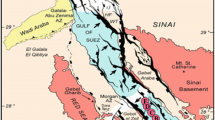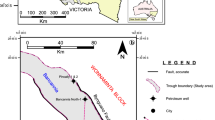Abstract
Beyond the traditional use of well logs, electrofacies were introduced to define a set of log responses that can be used to characterize a bed and permitted it to be distinguished from the other rock units. Classification of a formation into electrofacies can be used in reservoir characterization and discrimination. Due to the hydrocarbon potential of the Kareem Formation, we used the conventional well logs of four boreholes and a traditional core analyses data from one of these wells to identify electrofacies of the Kareem Formation in the Southern Gulf of Suez. Multivariate statistical analyses, such as principal component analysis ‘PCA’ and cluster analysis, were used for this purpose. The multivariate statistical analyses were applied to the raw log data, the normalized data and the standardized log data. Three PC components were obtained from the analyses, and six distinctive electrofacies were extracted from the dendrogram plot. These electrofacies showed good correlation with the lithofacies that were described from core analysis. In addition, applying the reservoir zonation of the studied formation using the stratigraphic modified Lorenz ‘SML’ plot and the sum of squared errors ‘SSE’ methods led to its discrimination into four hydraulic flow units. The deduced flow units were validated against the available core data.


Modified after EGPC (1996)










Similar content being viewed by others
References
Alsharhan AS (2003) Petroleum geology and potential hydrocarbon plays in the Gulf of Suez rift basin, Egypt. Bull AAPG 87(1):143–180
Amaefule J, Altunbay M, Tiab D, Kersey DG, Keelan DK (1993) Enhanced reservoir description using core and log data to identify hydraulic flow units and predict permeability in uncored intervals/wells. In: SPE annual technical conference and exhibition, 3-6 October, Houston, Texas, SPE 26436
Dorfman MH, Newey JJ, Coats GR (1990) New techniques in lithofacies determination and permeability prediction in carbonates using well logs. In: Hurst A, Lovell MA, Morton AC (eds) Geological applications of Wireline logs, vol 48. Geological Society, London, Special Publications. pp 113–120
Doveton JH (1994) Geologic log analysis using computer methods, vol 2. AAPG, Computer applications in geology, Tulsa
Doveton JH (2014) Principles of mathematical petrophysics. Oxford University Press, Oxford
EGPC ‘Egyptian General Petroleum Corporation’ (1964) Oligocene and Miocene rock-stratigraphy of the Gulf of Suez region. A report of the Stratigraphic Committee
EGPC ‘Egyptian General Petroleum Corporation’ (1996) Gulf of Suez oil fields (a comprehensive overview)
El Sharawy MS, Nabawy BS (2016) Geological and Petrophysical Characterization of the Lower Senonian Matulla Formation in Southern and Central Gulf of Suez, Egypt. Arab J Sci Eng 41(1):281–300
Elphick R, Moore R (1999) Permeability calculations from clustered electrofacies, a case study in Lake Maracaibo, Venezuela. In: 40th SPWLA annual symposium, Oslo, Norway
Evans AL (1988) Neogene tectonic and stratigraphic events in the Gulf of Suez rift area, Egypt. Tectonophysics 153(1–4):235–247
Fraley C, Raftery AE (2002) Model-based clustering, discriminant analysis, and density estimation. J Am Stat Assoc 97(458):611–631
Gunter GW, Finneran JM, Hartmann DJ, Miller JD (1997) Early determination of reservoir flow units using an integrated petrophysical method. In: SPE 38679
Iske A, Levesley J (2007) Algorithms for approximation proceedings of the 5th international conference. Springer, Berlin
Kadkhodaie-Ilkhchi R, Rezaee R, Moussavi-Harami R, Kadkhodaie-Ilkhchi A (2013) Analysis of the reservoir electrofacies in the framework of hydraulic flow units in the Whicher Range Field, Perth Basin, Western Australia. J Pet Sci Eng 111:106–120
Kumar B, Kishore M (2006) Electrofacies classification—a critical approach. In: 6th international conference and exposition on petroleum geophysics, Kolkata, India, pp 822–825
Lee SH, Datta-Gupta A (1999) Electrofacies characterization and permeability predictions in carbonate reservoirs: role of multivariate analysis and nonparametric regression. In: SPE-56658-MS
Maglio-Johnson T (2000) Flow unit definition using petrophysics in a deep water turbidite deposit, Lewis Shale, Carbon County, Wyoming. Publishing M.Sc. thesis, Colorado School of Mines
Montenat C, D’Estevou PO, Purser B, Burollet PF, Jarrige JJ, Orszag-Sperber F, Philobbos E, Plaziat JC, Prat P, Richert JP, Roussel N, Thiriet JP (1988) Tectonic and sedimentary evolution of the Gulf of Suez and the northwestern Red Sea. Tectonophysics 153(1–4):161–177
Moss B. (1997) The partitioning of petrophysical data: a review. In: Lovell, Harvey (ed) Developments in petrophysics, vol 122. Geological Society, Special Publication pp 181–252
Nabawy BS (2013) Impacts of dolomitization on the petrophysical properties of the Cenomanian El-Halal Formation, north Sinai, Egypt. Arab J Geosci 6(2):359–373
Nabawy BS (2015) Impacts of the pore- and petro-fabrics on porosity exponent and lithology factor of Archie’s equation for carbonate rocks. J Afr Earth Sc 108:101–114
Nabawy BS, Al-Azazi NAS (2015) Reservoir zonation and discrimination using the routine core analyses data: the upper Jurassic Sab’atayn sandstones as a case study, Sab’atayn basin, Yemen. Arab J Geosci 8(8):5511–5530
Nabawy BS, Sediek KN, Nafee SA (2015) Pore fabric assignment using electrical conductivity of some Albian-Cenomanian sequences in north Eastern Desert, Egypt. Arab J Geosci 8(8):5601–5615
Nabway BS, Kassab MA (2014) Porosity-reducing and porosity-enhancing diagenetic factors for some carbonate microfacies: a guide for petrophysical facies discrimination. Arab J Geosci 7(11):4523–4539
Nikravesh M, Aminzadeh F, Zadeh LA (2003) Soft computing and intelligent data analysis in oil exploration. Elsevier, Amsterdam, p 723
Omar GI, Steckler MS, Buck WR, Kohn BP (1989) Fission-track analysis of basement apatites at the western margin of the Gulf of Suez rift, Egypt: evidence for synchroneity of uplift and subsidence. Earth Planet Sci Lett 94:316–328
Omran MA, El Sharawy MS (2014) Tectonic evolution of the Southern Gulf of Suez, Egypt: a comparison between depocenter and near peripheral basins. Arab J Geosci 7(1):87–107
Patton TL, Moustafa AR, Nelson RA, Abdine SA (1994) Tectonic evolution and structural setting of the Suez rift. In: Landon SM (ed) Interior rift basins, vol 59. AAPG Memoir, pp 9–55
Perez HH, Datta-Gupta A, Mishra S (2005) The role of electrofacies, lithofacies, and hydraulic flow units in permeability predictions from well logs: a comparative analysis using classification trees. In: SPE-84301-PA
Raafat KT (1994) Petrophysical evaluation of Hilal field—Kareem Formation in the Gulf of Suez—Egypt. In: 12th EGPC exploration and production conference, vol 2. pp 432–448
Reading HG (1978) Facies. In: Reading HG (ed) Sedimentary environments and facies. Elsevier, New York, pp 4–14
Richardson M, Arthur M (1988) The Gulf of Suez—northern Red Sea Neogene rift: a quantitative basin analysis. Mar Pet Geol 5(3):247–270
Rider M, Kennedy M (2011) The geological interpretation of well logs, 3rd edn. Rider-French Consulting Limited, Sutherland
Rine JM (1985) Lithology and reservoir characteristics of Hilal-A5, Kareem Formation, interval 8065–8122 ft. GUPCO Unpublished Internal Report
Rushing JA, Newsham KE, Blasingame TA (2008) Rock Typing—Keys to understanding productivity in tight gas sands. In: SPE 114164
Schutz KL (1994) Structure and stratigraphy of the Gulf of Suez, Egypt. In: Landon SM (ed) Interior rift basin: AAPG Memoir, vol 59. pp 57–96
Serra O (1987) Análisis de ambientes sedimentarios mediante perfiles de pozo. Schlumberger Educational Services, Buenos Aires
Serra O, Abbott HT (1980) The contribution of logging data to sedimentology and stratigraphy. In: SPE 9270-PA
Slatt RM (2006) Stratigraphic reservoir characterization for petroleum geologists, geophysicists, and engineers: handbook of petroleum exploration and production, vol 6. Elsevier, Amsterdam, p 478
Steckler MS, Berthelot F, Lyberis N, Le Pichon X (1988) Subsidence in the Gulf of Suez: implications for rifting and plate kinematics. Tectonophysics 153:249–270
Stinco LP (2006) Core and log data integration; the key for determining electrofacies. In: SPWLA 47th annual logging symposium
Stinco L, Elphick R, Moore W (2001) Electrofacies and production prediction index determination in El Tordillo Field, San Jorge Basin, Argentina. In: 42nd society of professional well log analyst annual symposium, Houston
Teh WJ, Willhite GP, Doveton JH (2012) Improved reservoir characterization using petrophysical classifiers within electrofacies. In: SPE 154341-PP
Tewfik N, Harwood C, Deighton I (1992) The Miocene, Rudeis and Kareem Formations in the Gulf of Suez: Aspects of sedimentology and geohistory. In: 11th EGPC exploration seminar, vol 1. Cairo, pp 84–113
Acknowledgements
The authors would like to thank the reviewers for their great comments that improved and reconstructed the manuscript. We would like also to give thanks to the Editor-in-Chief Prof. Dr. Gunter Doerhoefer whose patience and insightful suggestions have led to a new concise revised version. Thanks have to be extended to the Egyptian General Petroleum Corporation ‘EGPC’ and the Gulf of Suez Petroleum Company ‘GUPCO’ for releasing the data. Eventually, the science and technology development fund ‘STDF’ of Egypt has to be acknowledged for introducing the fund of the present study through project number 4097.
Author information
Authors and Affiliations
Corresponding author
Rights and permissions
About this article
Cite this article
El Sharawy, M.S., Nabawy, B.S. Determination of electrofacies using wireline logs based on multivariate statistical analysis for the Kareem Formation, Gulf of Suez, Egypt. Environ Earth Sci 75, 1394 (2016). https://doi.org/10.1007/s12665-016-6214-0
Received:
Accepted:
Published:
DOI: https://doi.org/10.1007/s12665-016-6214-0





